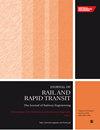Rail-wheel friction quantification and its variability under lab and field trial conditions
IF 1.7
4区 工程技术
Q3 ENGINEERING, CIVIL
Proceedings of the Institution of Mechanical Engineers Part F-Journal of Rail and Rapid Transit
Pub Date : 2023-10-28
DOI:10.1177/09544097231209483
引用次数: 0
Abstract
Friction forces (often referred to as adhesion or traction forces) at the wheel/rail interface can vary dramatically due to changing environmental and contact conditions. The causes of this variance are partially documented, but it is not fully understood. Friction forces affect wheel and rail wear, traction energy usage, vehicle dynamics and safety through braking performance. A range of different portable railhead tribometers are used in the field to measure friction, but until recently have been limited in their performance, being unable to measure low friction situations or have made use of an unrealistic contact geometry. Recent developments have improved this situation but there is currently a lack of published field data which is required for validation, benchmarking and comparison between other studies and test rigs, as well as for input to multi-body dynamics simulations of railway vehicles. Friction studies in general are often undertaken for a specific period of time or under closely controlled conditions which makes it difficult to understand the true range of conditions occurring in the wheel/rail contact. In this paper an extensive dataset of railhead measurements is presented, using two types of measuring devices and three railhead conditions throughout a 4-week test period. Confidence in tribometer results was gained by comparing between established laboratory friction test rigs and methodologies. The results provide an insight into the friction variance and transient conditions that would occur on the railhead during operational use.轨道轮摩擦量化及其在实验室和现场试验条件下的可变性
由于环境和接触条件的变化,轮轨界面的摩擦力(通常称为附着力或牵引力)会发生巨大变化。造成这种差异的原因有部分文献记载,但尚未完全了解。摩擦力通过制动性能影响轮轨磨损、牵引能量使用、车辆动力学和安全性。一系列不同的便携式导轨摩擦计在现场用于测量摩擦,但直到最近,它们的性能一直受到限制,无法测量低摩擦情况或使用不切实际的接触几何形状。最近的发展已经改善了这种情况,但目前缺乏公开的现场数据,这些数据需要用于验证、基准测试和其他研究和测试平台之间的比较,以及用于输入铁路车辆的多体动力学模拟。一般来说,摩擦研究通常是在特定的时间内或在严格控制的条件下进行的,这使得很难理解轮轨接触中发生的真实条件范围。本文提供了一个广泛的铁路轨道测量数据集,在4周的测试期间使用两种类型的测量设备和三种铁路轨道条件。通过比较已建立的实验室摩擦试验台和方法,获得了对摩擦计结果的信心。结果提供了一个洞察摩擦变化和瞬态条件,将发生在铁路的运行使用期间。
本文章由计算机程序翻译,如有差异,请以英文原文为准。
求助全文
约1分钟内获得全文
求助全文
来源期刊

CiteScore
4.80
自引率
10.00%
发文量
91
审稿时长
7 months
期刊介绍:
The Journal of Rail and Rapid Transit is devoted to engineering in its widest interpretation applicable to rail and rapid transit. The Journal aims to promote sharing of technical knowledge, ideas and experience between engineers and researchers working in the railway field.
 求助内容:
求助内容: 应助结果提醒方式:
应助结果提醒方式:


